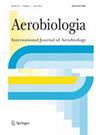Atmospheric particulate matter deposition on birch catkins and pollen grains before pollination
Abstract
Birch is the most allergenic tree species in Northern and Central Europe. Airborne birch pollen concentrations are observed to be on the rise for several decades. Health hazard due to birch pollen grains (BPGs) can worsen due to particulate air pollution. The prevalence of the intimate mixture of BPGs with atmospheric particulate matter (APM) at the single pollen grain level is still unraveled. In this study, APM transfer mechanisms to birch catkins and BPGs prior to pollination were investigated at an urban-industrial and a peri-urban site in Northern France. The surface of catkins was heavily polluted with micrometer-sized particles. Conversely, BPGs were relatively unpolluted with on average 0.1 particle.BPG−1. Differences in the chemical composition of adhered particles were observed as a function of the sampling sites. In contrast, no significant difference was found in terms of surface concentrations of APM adhered to BPGs and catkins between the two sites. Comparison of the number of particles deposited per pollen grain according to whether they were harvested from catkins or collected while airborne suggests that particulate pollution of pollen occurs preferentially after pollen shedding, either by impaction or coagulation mechanisms with other suspended APM or by pollen settling on dust-contaminated surfaces followed by resuspension.


 求助内容:
求助内容: 应助结果提醒方式:
应助结果提醒方式:


